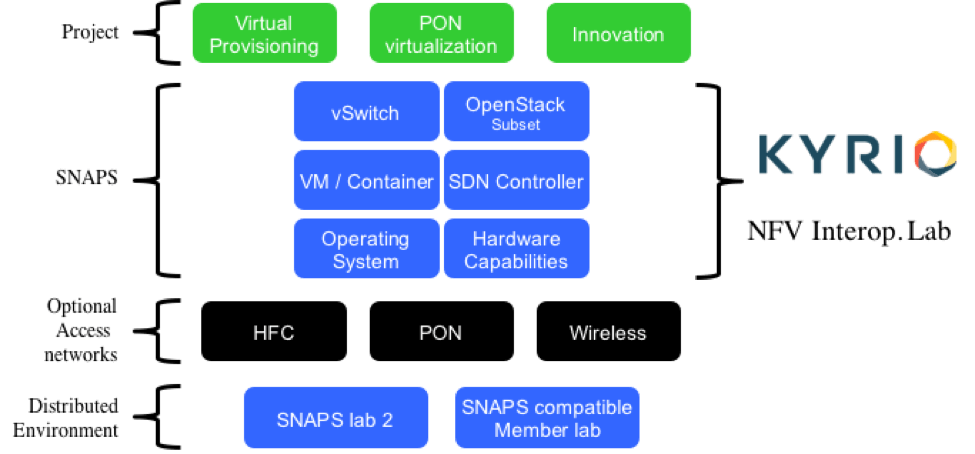Virtualization
Snapping Together a Carrier Grade Cloud

Today's enterprise and hyper-scale cloud solutions will not deliver everything needed to virtualize the service providers’ networks. However, cloud solutions do provide many of the building blocks as a great starting point.
Current Environment
Service providers are evolving their networks and services to better meet customer needs and expectations. Hosted applications are continuously updated with new features and consumers are starting to demand a similar frequency of change with services innovation. This rate of change and innovation in service provider networks will not be achieved by rolling more and more specialized hardware boxes to tens of millions of customers. Delivering software-based network solutions that reduce dependency on specialized hardware boxes is the only way to meet these customer expectations.
End users' expectation for service quality continues to increase, and they are typically not willing to accept a tradeoff between performance and capabilities. They want both increased performance and increased capabilities. Service Level Agreements (SLAs) are typically required for enterprise customers, but simply over-provisioning dedicated resources to meet these needs is neither economic, nor sustainable. High performance and network proximity are key to delivering interactive voice and video solutions with high bandwidth and low latency. No one wants to be misunderstood when delivering nuanced details during a videoconference with their stakeholders!
Currently, network services are delivered on several specialty devices located at customer sites or hosted by operators. Today, these specialty devices only provide a subset of needed capabilities and physical upgrades are both expensive and time consuming.
Critical Success Factors
Performance
In addition to being consistent and predictable, the network must be fast. There are no milliseconds to spare while moving across the network. For time sensitive applications such as cellular networks, there is no tolerance for physically routing packets inappropriately. They need to traverse the quickest route to their ultimate destination. To use a reference from "Smokey and the Bandit," one of my favorite movies, Bandit (Burt Reynolds' character) didn't drive through New York City to win the race from Texas to Georgia. He took the shortest and fastest route possible. Network traffic needs to do the same thing. Stick to the fastest and most direct route and only deviate when absolutely necessary,
This is not the natural mode for software running in an interrupt-driven multi-tasking environment. Much like humans trying to multi-task, tasks tend to take much longer if we are very busy. Software needs to be configured to prevent or bound interference when multiple workloads are running on the same computer.
Location
"Location, location, location" is as important to network virtualization as it is to real-estate. Virtual Network Functions (VNFs) are the software components that replace the current Physical Network Functions (PNFs). VNFs need to be strategically placed, including positioning at the customer site or even other service provider nodes. Managing Wi-Fi networks requires access to devices at customer sites. Even when offloading the majority of the work to a hosted cloud, there are still physical accesses, routing and local security workloads that are best hosted on the customer site.
Low latency services, such as Content Delivery Networks need caching instances to be located relatively close to the customer site to reduce latency and core network bandwidth. Storage of data should not be on the other side of a busy or slow network connection. The path the data takes over the network needs to provide a consistent user experience. The network also needs to be flexible, as it must adapt to varying network loads and outages. Typically, enterprise cloud applications are designed for high availability and low cost. Speedier customer use is not always a consideration. The ability to easily manage service delivery locations by automatically placing and moving workloads within a data center, or geographically is a must for virtualizing network services.
Interoperability
VNFs must work with the deployed Network Function Virtualization (NFV) infrastructure and hardware. Should each VNF require a different infrastructure, it would be nearly impossible to manage and would cost much more to deploy. Interoperability can enable more competition and a broader set of vendors to deliver network services. Competition drives innovation. Standards and interoperability drive economies of scale.
ETSI-NFV is leading the way in developing the foundational standards for NFV based on a set of use cases and requirements coming from industry. Other standards bodies are referencing the ETSI-NFV work to address application-specific needs. These standards are becoming the basis for defining interoperability. But as with any standards effort, there will be many interpretations and implementations that follow these guidelines.
All of the independent components will need to be validated at key touch points to ensure interoperability and there is still no single test suite available today that will guarantee interoperability between VNFs or between VNFs and the infrastructure that hosts them. To help address this issue, ETSI-NFV is developing test specifications that are being referenced by OPNFV which itself was initiated by the ETSI NFV co-founders to accelerate implementation and feedback on the NFV specifications.
Looking Ahead
Over the next two to three years, we should see NFV being incorporated in mainstream cloud platforms. The expected performance and interoperability enhancements will increase the efficiency of compute and networking resources while requiring less power and space to run the same work. The improved, distributed nature of a trusted cloud will simplify managing applications running on or near the customers’ locations.
What CableLabs is Doing
CableLabs’ SDN/NFV Application development Platform and Stack project (SNAPS for short) is just one of the initiatives at CableLabs that attempts to accelerate and ease the adoption of network virtualization.

We are identifying the performance needs for network virtualization by evaluating the best open source software components and commercially available servers in order to build a stable and replicable platform for developing and demonstrating virtualized network capabilities and to validate interoperability and repeatability. Currently, the SNAPS project leverages a specific configuration of OPNFV which is being tested and hardened. Many of our enhancements have been included in the OPNFV "Colorado" release of the Apex installer.
Sharing our Expertise
While trying out different OpenStack installers, we soon ran into the dilemma of how to quickly use and validate our cloud in a repeatable manner. In response, we created a Python library whose responsibility is to deploy and provision OpenStack tenants from which we built a set of test suites to perform this validation. While the test suite tools are still under development, we have already made them available under the Apache v2 open source license in CableLabs' C3 collaborative software environment.
Additional contributors are always welcome. The source repository is located here: https://gerrit.cablelabs.com/#/admin/projects/snaps-provisioning
Accelerating NFV Adoption
The SNAPS project team, consisting of CableLabs member companies and vendors, is currently generating requirements and defining use cases to be shared publicly. These requirements include both performance and interoperability guidelines.
CableLabs wholly owned subsidiary Kyrio is using the lessons learned through this R&D process to drive evolution of the Kyrio SDN/NFV Interoperability lab.
We are actively involved in OPNFV and OpenDaylight, and we actively contribute to ETSI NFV.

